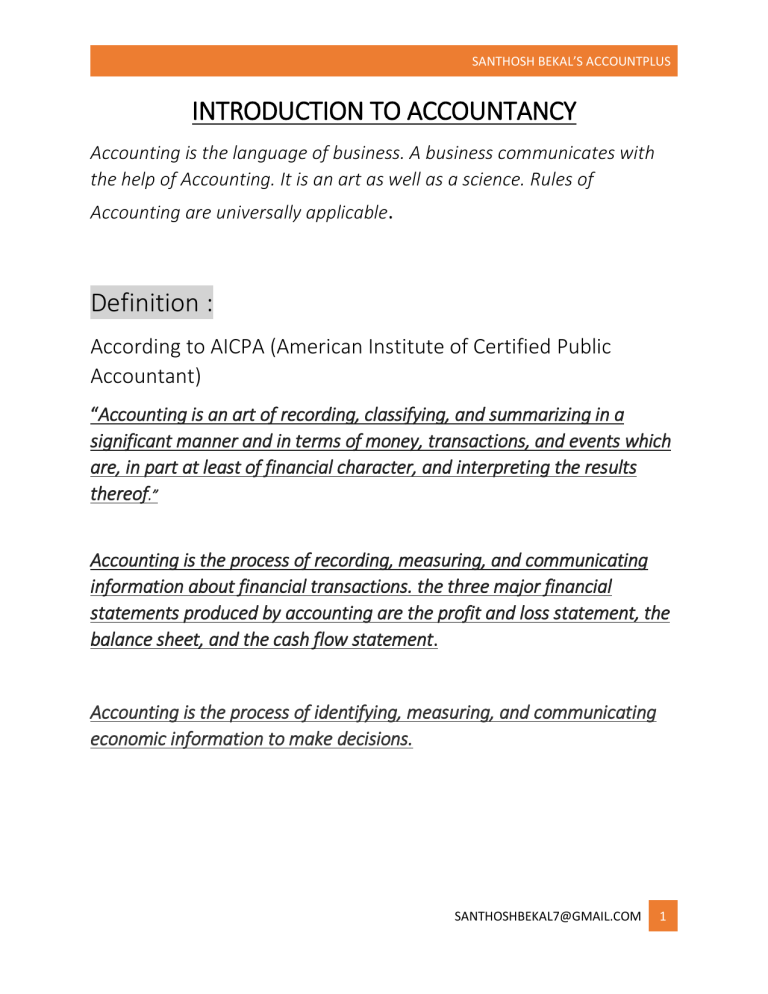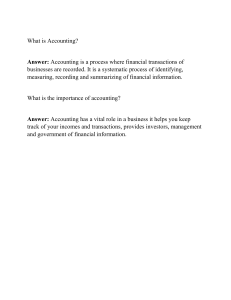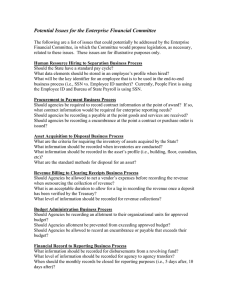
SANTHOSH BEKAL’S ACCOUNTPLUS INTRODUCTION TO ACCOUNTANCY Accounting is the language of business. A business communicates with the help of Accounting. It is an art as well as a science. Rules of Accounting are universally applicable. Definition : According to AICPA (American Institute of Certified Public Accountant) “Accounting is an art of recording, classifying, and summarizing in a significant manner and in terms of money, transactions, and events which are, in part at least of financial character, and interpreting the results thereof.” Accounting is the process of recording, measuring, and communicating information about financial transactions. the three major financial statements produced by accounting are the profit and loss statement, the balance sheet, and the cash flow statement. Accounting is the process of identifying, measuring, and communicating economic information to make decisions. SANTHOSHBEKAL7@GMAIL.COM 1 SANTHOSH BEKAL’S ACCOUNTPLUS The basic purpose of accounting is to act as a steward to the company owners and other interested parties in a business Interested parties (users) include Owner / Investor: The owner is the person who started the business. He/she is an internal user. He/she is interested to know profit or loss of business Managers: A manager is a person who manages the company. He is an internal user is an interest to know profit or loss of business Shareholders: People who subscribe (purchased) share of the company. They also interested to know the profit and loss of the company. Creditors: People who gave money to the company as loan also interest to know the capacity of the company Government: Government also interests to know the profit and loss of the company to collect the tax. Agencies: that have a stake in the company and are entitled to receive financial reports. SANTHOSHBEKAL7@GMAIL.COM 2 SANTHOSH BEKAL’S ACCOUNTPLUS 1. Accounting is an art of recording : Recording transactions is the main function of accounting. Recording means systematically writing down in account books the transactions all the business transaction is recording first in the book called a journal. 2. It involves classifying, and summarizing: Classifying is the process of a grouping of transactions or entries of one nature in one place. This is done by opening accounts in a book called the ledger. Summarizing involves the preparation of reports and statements from the classified data [i.e., ledger]. This involves the preparation of final accounts. 3. It records transactions in terms of money: This provides a common measure of recording and increases the understanding of the state of affairs of the business. 4. It records only those transactions and events, which are financial. Non-financial events, howsoever important they may be for the business, are not recorded in accounting. 5. It is the art of interpreting the results of operations: It aids to determine the financial position of the enterprise, the progress it has made, and how well it is getting along. SANTHOSHBEKAL7@GMAIL.COM 3 SANTHOSH BEKAL’S ACCOUNTPLUS 6. It involves communication: The results of analysis and interpretation are communicated to the management and other interested parties. FUNCTION OF ACCOUNTING a) Keeping Systematic Records: As a language of business, accounting is to report the results of most business events. Hence, its main function is to keep a systematic record of these events. The primary function of accounting is recording transactions in journal and subsidiary books like cashbooks, sales books, etc., posting them to ledger accounts and preparing the financial statements. (b) Communicating the Results: The second main function of accounting is to communicate the financial facts of the enterprise to the various interested parties like owners, investors, creditors, employees, government, and research scholars, etc. (c) Meeting Legal Requirements: Accounting aims at fulfilling the legal requirements, especially of the tax authorities and regulators of the business. (d) Protecting the Properties of the Business: Accounting helps in protecting the property of the business. (e) Planning and Controlling Business Activities: Accounting also helps in planning future activities of an enterprise and controlling its day-to-day operations. SANTHOSHBEKAL7@GMAIL.COM 4 SANTHOSH BEKAL’S ACCOUNTPLUS According to the golden rules of accounting, accounts are divided into three categories. These are explained with the examples as following: – 1. Real Accounts: The real account is related to all assets of the business enterprise. This rule applies to the transactions like purchase of an asset, sale of an asset, depreciation charged on an asset, and dispose of an asset. The asset is that valuable thing or property which the business owns and get the benefits from it in the future or use it in generating income. The example of assets on which the Real Account is applicable: Land and Building, Furniture Plant and Machine Vehicles Cash Trademarks Copyright 2. Personal Accounts: This rule applies to all individuals. The individuals are three types shown as following: – 1. Persons: – Natural Person. 2. Artificial persons: – The person created by humans. 3. Representative persons: – Those accounts which represent the person or group of persons. Example of accounts on which the Personal Account is applicable: – Examples of Persons: – Amanpreet, Jazz, Pawan Kumar, Vijay, Amir Khan. Etc. Examples of Artificial persons: – Ram And Sons., HAPPSS Store., Bank A/c (SBI), Reliance Industries Ltd. Etc. Examples of Representative persons: – Outstanding Salary, Prepaid Expenses, Accrued Income, Prereceived Income, Etc. SANTHOSHBEKAL7@GMAIL.COM 5 SANTHOSH BEKAL’S ACCOUNTPLUS 3. Nominal Accounts: The accounts which are related to the expenses, income, losses, and gains are included in the nominal account. Expenses Accounts: –Salary, Wages, Purchases, Electricity bill, Telephone, and mobile Rent, Transportation charges, Rent Paid, Etc. Incomes Accounts: – Sales, Commission Received, Rent on sublet building received, Etc. Losses Accounts: – Loss on sale of an asset, Loss by Theft, Loss by fire, loss by an accident, Etc. Profits Accounts: – Profit on sale of an asset, Etc. Type of Accounts The Golden Rules of Accounting Debit: What comes in 1. Real Accounts Credit: What goes out Debit:- The Receiver 2. Personal Accounts Credit: The Giver Debit:- All Expenses and Losses 3. Nominal Accounts Credit:- All income and gains MODERN LAW OF ACCOUNTING SANTHOSHBEKAL7@GMAIL.COM 6





